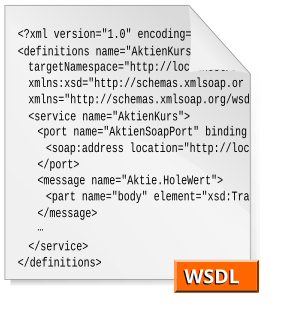SOAP is a messaging protocol specification for exchanging structured information in the implementation of web services in computer networks. Its purpose is to provide extensibility, neutrality and independence. It uses XML Information Set for its message format, and relies on application layer protocols, most often Hypertext Transfer Protocol (HTTP) or Simple Mail Transfer Protocol (SMTP), for message negotiation and transmission.
Web Services Security is an extension to SOAP to apply security to Web services. It is a member of the Web service specifications and was published by OASIS.
The WS-I Basic Profile, a specification from the Web Services Interoperability industry consortium (WS-I), provides interoperability guidance for core Web Services specifications such as SOAP, WSDL, and UDDI. The profile uses Web Services Description Language (WSDL) to enable the description of services as sets of endpoints operating on messages.
The Web Services Interoperability Organization (WS-I) is an industry consortium chartered to promote interoperability amongst the stack of web services specifications. WS-I does not define standards for web services; rather, it creates guidelines and tests for interoperability. It is part of OASIS, another standards body.
Security Assertion Markup Language is an open standard for exchanging authentication and authorization data between parties, in particular, between an identity provider and a service provider. SAML is an XML-based markup language for security assertions. SAML is also:
The Central Authentication Service (CAS) is a single sign-on protocol for the web. Its purpose is to permit a user to access multiple applications while providing their credentials only once. It also allows web applications to authenticate users without gaining access to a user's security credentials, such as a password. The name CAS also refers to a software package that implements this protocol.
Web Services Discovery provides access to software systems over the Internet using standard protocols. In the most basic scenario there is a Web Service Provider that publishes a service and a Web Service Consumer that uses this service. Web Service Discovery is the process of finding suitable web services for a given task.
WS-Policy is a specification that allows web services to use XML to advertise their policies and for web service consumers to specify their policy requirements.
The Java API for XML Web Services (JAX-WS) is a Java programming language API for creating web services, particularly SOAP services. JAX-WS is one of the Java XML programming APIs. It is part of the Java EE platform.
Web Services Interoperability Technology (WSIT) is an open-source project started by Sun Microsystems to develop the next-generation of Web service technologies. It provides interoperability between Java Web Services and Microsoft's Windows Communication Foundation (WCF).

Apache Axis2 is a core engine for Web services. It is a complete re-design and re-write of the widely used Apache Axis SOAP stack. Implementations of Axis2 are available in Java and C.
Apache Rampart is an implementation of the WS-Security standard for the Axis2 Web services engine by the Apache Software Foundation. It supplies security features to web services by implementing the following specifications:
Web Services Enhancements (WSE) is an obsolete add-on to the Microsoft .NET Framework, which includes a set of classes that implement additional WS-* web service specifications chiefly in areas such as security, reliable messaging, and sending attachments. Web services are business logic components which provide functionality via the Internet using standard protocols such as HTTP. Web services communicate via either SOAP or REST messages. WSE provides extensions to the SOAP protocol and allows the definition of custom security, reliable messaging, policy, etc. Developers can add these capabilities at design time using code or at deployment time through the use of a policy file.
WS-Trust is a WS-* specification and OASIS standard that provides extensions to WS-Security, specifically dealing with the issuing, renewing, and validating of security tokens, as well as with ways to establish, assess the presence of, and broker trust relationships between participants in a secure message exchange.
WS-Federation is an Identity Federation specification, developed by a group of companies: BEA Systems, BMC Software, CA Inc., IBM, Microsoft, Novell, HP Enterprise, and VeriSign. Part of the larger Web Services Security framework, WS-Federation defines mechanisms for allowing different security realms to broker information on identities, identity attributes and authentication.
WS-SecurityPolicy is a web services specification, created by IBM and 12 co-authors, that has become an OASIS standard as of version 1.2. It extends the fundamental security protocols specified by the WS-Security, WS-Trust and WS-SecureConversation by offering mechanisms to represent the capabilities and requirements of web services as policies. Security policy assertions are based on the WS-Policy framework.
WS-SecureConversation is a Web Services specification, created by IBM and others, that works in conjunction with WS-Security, WS-Trust and WS-Policy to allow the creation and sharing of security contexts. Extending the use cases of WS-Security, the purpose of WS-SecureConversation is to establish security contexts for multiple SOAP message exchanges, reducing the overhead of key establishment.

The Web Services Description Language is an XML-based interface description language that is used for describing the functionality offered by a web service. The acronym is also used for any specific WSDL description of a web service, which provides a machine-readable description of how the service can be called, what parameters it expects, and what data structures it returns. Therefore, its purpose is roughly similar to that of a type signature in a programming language.



